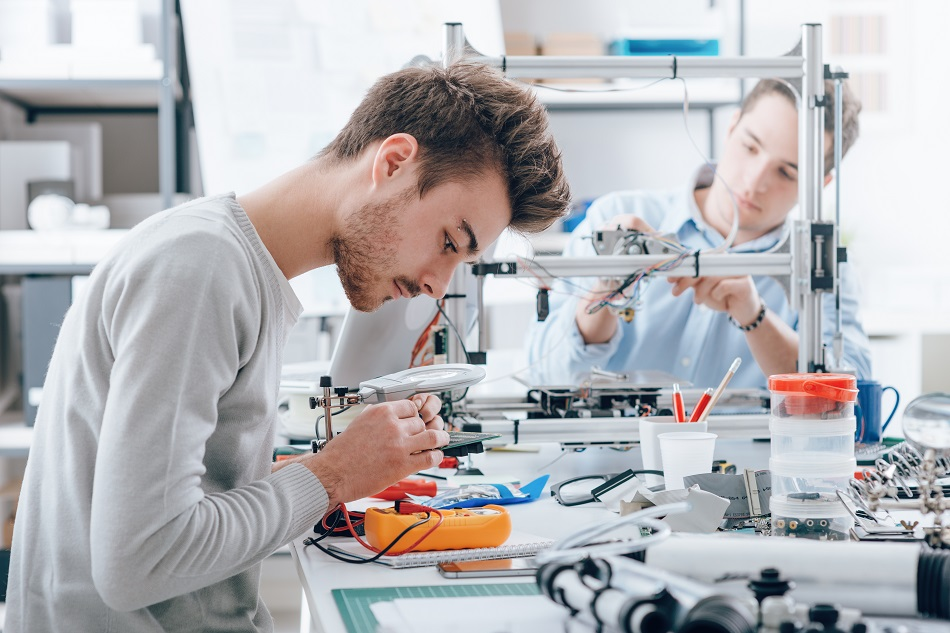
Image Credit: Stock-Asso/Shutterstock.com
In the laboratory, it is important that all the right tools and equipment are present if a research study or set of experiments is to be carried out correctly. Choosing the correct equipment can be especially important if budgetary constraints are to be considered. Researchers should always be mindful of these factors and the unique needs of the study being carried out before choosing what to use in the laboratory setting.
Over the years, a staggering amount of specialized lab equipment has been developed, with modern-day computer-aided equipment taking more of an active role in all kinds of projects. For the engineer, this is no different than any other scientist, as the demands of their particular field of study need specific, specialized lab equipment if their work is to be carried out to the best of their ability. Some of the essential laboratory equipment for engineers is discussed in this article.
Mechanical Hand Tools
The basics of any engineering toolkit, mechanical hand tools also have their place within the laboratory, whether it is a small research lab or large commercial enterprise. Simple tools including wire strippers, shear cutters, precision screwdrivers, leads, and alligator clips should all be on hand to make complex tasks much easier and help with the basic tasks.
General Laboratory Equipment
As the needs of a project can be varied, it is prudent to have general lab equipment on hand to carry out the functions necessary for accurate testing. This can include freezers, hot plates, fume hoods, and Bunsen burners.
Multimeter
A multimeter (otherwise known as a multitester or VOM) is an essential piece of equipment that is one of the most widely used tools in engineering laboratories. They can either have analog or digital displays and measure voltage, current, and resistance. There are two versions of the multimeter – hand-held and bench instruments, which can measure values to a high degree of accuracy.
Variable DC Power Supply
Safety in the lab should be of paramount concern to any engineer. A variable D.C. power supply will convert mains A.C to D.C., reducing the risk of electrical shock and overloads. A variable power supply can be set to the desired levels by the operator and if there are problems (for example, an electrical surge) the entire bench will be shut down automatically to avoid any injuries or damage to the product being tested.
Oscilloscope
Another essential piece of lab equipment for any engineer is an oscilloscope; a complex piece of machinery that captures, processes, displays, and analyzes the waveform and bandwidth of electronic signals, producing a readable graph of the signal voltage. Another useful piece of equipment is a waveform generator.
Mechanical Equipment
As any engineering project requires significant amounts of time dedicated to manufacturing physical products, a modern engineering laboratory should include a range of manufacturing tools including lathes, saws, broaching machines, drill presses, shapers, milling machines, and CNC (computer numerical control) machine tools. Good quality machinery with solid safety mechanisms should be chosen.
CAE (Computer-Aided Engineering) Equipment
In recent decades, software-based lab equipment has played a pivotal role in multiple studies and projects. Computer-aided engineering (CAE) is the use of software to provide performance simulations. CAE optimizes product design and can assist in the resolution of engineering problems.
There are three product steps in a typical CAE process: preprocessing, solving, and postprocessing. In preprocessing, the geometry, physical design properties, and the environment (applied loads/constraints) are modeled by engineers. In the solving phase, the model is solved by mathematical formula. Postprocessing involves presenting the results to the engineer for review.
CAE equipment is used in stress testing, control systems analysis, acoustic analysis, and mechanical event simulation (MES.) There are several advantages to using computer-aided engineering; one main advantage is that because the system being designed is modeled in a computer program, no prototype needs to be constructed therefore saving cost and time.
Other Equipment
As has been mentioned, any equipment in the lab must be chosen to fit the desired specifications of the project. There are hundreds of different types of equipment available for the engineering laboratory, too many to mention in this article. Other specialized equipment used in many different areas of engineering include:
- Photometers
- Microscopes
- Spectroscopy equipment (including FT-IR spectrometers)
- Flow-through thermocyclic test machines
- Deflection temperature testers
- Thermocyclic test rigs
- Walk-in temperature test chambers
Sources and Further Reading
Disclaimer: The views expressed here are those of the author expressed in their private capacity and do not necessarily represent the views of AZoM.com Limited T/A AZoNetwork the owner and operator of this website. This disclaimer forms part of the Terms and conditions of use of this website.